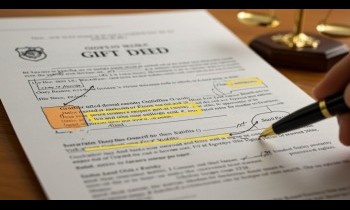How long does it take to get the court judgment on a cheque bounce case in India?

Date : 03 May, 2021
Post By Bhupender Tanwar
Cheque bounce cases are very common in India, cheque bounce is the case where when the person applies for the cheque and it bounces because of a non-sufficient amount in the bank account. If the cheque is bounced then the cheque beneficiary sent the drawer a legal notice to let him know that he/she is going to take legal actions against him, legal notice is one just the first step to take legal actions but to give him a chance to make the amount which has been made through cheque but the cheque got bounced. We will discuss in this blog What is a cheque? What is the cheque bounce case procedure? Punishment for cheque bounce case in India, how to escape from cheque bounce case? How long does it take to get the court judgment on cheque bounce in India? How long does a cheque bounce case take? What is the cheque bounce case duration?
Cheque: A bill of exchange to make the payment of a certain amount is known as a cheque. The person who issues the cheque is known as “drawer” and the person to whom the cheque is given or the person whose name is mentioned on the cheque or on whose name the cheque has been issued is called “drawee”. Cheque is one of the ways for making payments which is very common and almost used everywhere like for payments of salary, for payment of the bills, for the payments of the fees, etc. payments through cheque is considered as the reliable method to pay as it has the name of the drawer so it's not very difficult to recover the amount in case of any fault.
Essential Elements of a Cheque: There are certain elements that are required or essential to make a cheque valid, which are as follows:
It should be written: The cheque that has been issued should be in writing if someone orders any payment that is not considered a cheque.
It should be drawn on the banker: The cheque which is issued, cheque should always be issued on the specific bank where the drawer has any type of account like savings, current, etc.
Unconditional: The cheque is issued for any sort of payment, which means it can not depend on any conditions. The payments should be unconditional.
Specified amount: The cheque always required a specific amount of sum. There has to be a certain amount filled on the top of the cheque, for example, the cheque is of “10,000 Rupees”, this is considered as valid cheque but if instead of the amount it has been written that the cheque is for “payment of a washing machine”, this is invalid.
Date and Signature: The Cheque is only valid and only be paid if it is duly signed by the drawer and the date on which the cheque has been issued should also be mentioned.
Payable on demand: It is always payable on demand.
Validity of cheque: Generally a cheque is considered valid till six months from the date it has been issued, therefore it is important to mention the date when the drawer is issuing it. After the expiry of the six months, the cheque cannot be payable.
Liability of Banker: The banker is only liable to the drawer and in case of dishonoring of the cheque holder or bearer has no remedy against the banker.
Acceptance or Stamp: For issuing of cheques, there is no need for any type of acceptance or any type of stamp. Only the drawer has to mention whom to whom he/she is writing the cheque and the amount and at the end, the drawer has to sign the cheque.
Contents of a Cheque: There are certain important things that need to be mentioned on the cheque to make them valid.
At the top the name of the banker is important. The banker should be the one where the drawer has any type of account.
The name of the person to whom the cheque has been issued or the drawee.
The amount for which the cheque has been issued or the amount that the drawer wants to pay.
The date on which the cheque has been issued by the drawer.
The signature of the drawer is another most important content without which the drawee won’t be able to get paid.
Information Required in Case of Cheque Bouncing before Sending Legal Notice: If the cheque has been bounced then the drawee can be paid by filing the case into the court but before filing case the drawee has to send the drawer a legal notice mentioning the bouncing of the cheque but to send a legal notice there are certain information which is important for making and sending the legal notice are as follows: The date when the cheque has been issued by the drawer should be mentioned. The date of the presentation of the cheque is another important piece of information. Reason for the non-realization of the amount. When the Notice for the Bouncing of Cheque can be issued: The legal notice for cheque bounce can be issued in the following circumstances: If the cheque has been presented to the bank within the six months from the date drawer issued the cheque. The dishonoring of the cheque should be due to the non-sufficient amount in the bank account. The drawer did not pay the amount within 15 days from the date of serving the notice regarding the cheque bounce. The drawee or the person to whom the cheque had been issued informed the drawer or the maker of the cheque about the cheque bouncing within 30 days from the date cheque had been bounced. In case the cheque had been issued for settling any past payments that case also the notice can be sent. How to Send Notice regarding Cheque Bounce: Section 138 of the Negotiable Instrument Act provides that legal notice shall be issued in case of cheque bounce. The procedure to send a legal notice is as follows:- Find a lawyer who is having excellent drafting skills. Give him/her details or description about the issue or the matter and communication made between them regarding the issue or matter The lawyer will draft the notice either in your presence or after drafting he/she will give the letter to you for reading and in case there is anything the drawee wants to add or omit. The legal notice regarding the cheque bouncing should be signed by the drawee or sender and the lawyer both. The legal notice should be sent by post or in person and acknowledgment should be taken. After receiving the notice if the drawer is not responding then the lawyer should communicate regarding the notice. The essential elements that need to be mentioned in the legal notice are as follows: Name of the person to whom the cheque had been issued or the cheque beneficiary. Name and address of the person who issued the check or the drawer. The date on which cheque had been returned. The reason why the cheque had been returned. The drawee or the cheque beneficiary needs to mention the request for the payment. It should be issued under section 138 of the Negotiable Instruments Act. Laws related to Cheque Bounce: Cheque Bounce new law in India 2020 was proposed by the finance minister to decriminalize the offence of dishonoring the cheque. It was stated that dishonoring of cheque results in a criminal proceeding which is punished by imprisonment or fine or both. Court proceedings or criminal court cases take time to be solved which might affect the business or the investment in the business from domestic or foreign investors. Therefore making it decriminalized will help them especially in cases where there is no intent to commit any fraud. They also proposed to make changes in certain other laws like; Section 12 of the Insurance Act. Section 29 of the SARFAESI Act. Section 16(7) and section 32(1) of the PERDA Act. Section 58 of the RBI Act. Section 26(1) & 26(4) of the Payment and Settlement System Act. Section 56(1) of the NABARD Act. Section 49 of the NHB Act. Section 42 of the State Financial Corporation Act. Section 23 of the Credit Information Companies Act. Section 23 of the Factories Regulation Act. Section 37 of the Actuaries Act. Section 36AD(2) and section 46 of the Banking Regulation Act. Section 138 of the Negotiable Instrument Act. Etc. Cheque Bounce Case Judgments: Latest Judgments of Supreme Court on NI Act 138 in 2020; In Re: Expeditious Trial of Cases under Section 138 of the Negotiable Instrument Act: In this case, Supreme Court has stated that the cases related to cheque bounce are increasing in numbers and it is important to take action quickly to reduce the number of pending cases. The Supreme Court has passed the order on the video conference hearing that the High Court have to take actions in cheque bounce case within 4 weeks when the Court is taking suo motu action and within 2 weeks the high court has to submit a report regarding dishonoring of cheque and regrading the order made by Supreme Court. In other case of K.Bhaskaran v. Sankaran Vaidhya Balan, the Supreme Court held that determining the jurisdiction of the case cannot only depend on the place on dishonoring the cheque, dishonouring of the cheque is not by itself an offence but it is committed by the drawer when he fails to make the payment within 15 days from the receiving of legal notice under section 138(c). Therefore it was held that if any of these acts are committed then the court which has the jurisdiction where any of these acts had been committed have the jurisdiction to trial the case. Get in touch with the best cheque bounce lawyer Procedure to initiate a case regarding Cheque Bounce: The Drawee or the cheque beneficiary will have to deposit the cheque within six months from the date the cheque has been issued by the drawer. If the cheque had been bounced then within 30 days from the date of cheque bouncing the drawee or the beneficiary has to send the notice to the drawer regarding the cheque bouncing to let him/her know and to tell him/her to make the payment, also need to mention the reason for the cheque bounce. The drawer has to respond to the legal notice within 15 days from the date he/she receives the notice and to make payment. If the drawer failed to make payment within 15 days from the expiry of the notice then the drawee has to file a case within 30 days from the date the drawer received the notice. The complaint or the case should be filed in the court where the cheque had been bounced or where the court has jurisdiction. Once the case will be filed then the court will decide the date of the hearing and will summon the drawer and the drawee. The punishment or penalty for the case would be imprisonment which may extend to 2 years or more or fine or both. The cases related to cheque bounce can be lengthy and it might take 2 to 5 years to be resolved.






Prakash Chandra